
LOADING ...
In response to evolving domestic opinion, eMedals Inc has made the conscious decision to remove the presentation of German Third Reich historical artifacts from our online catalogue. For three decades, eMedals Inc has made an effort to preserve history in all its forms. As historians and researchers, we have managed sensitive articles and materials with the greatest of care and respect for their past and present social context. We acknowledge the growing sentiments put forth by the Canadian public and have taken proactive actions to address this opinion.
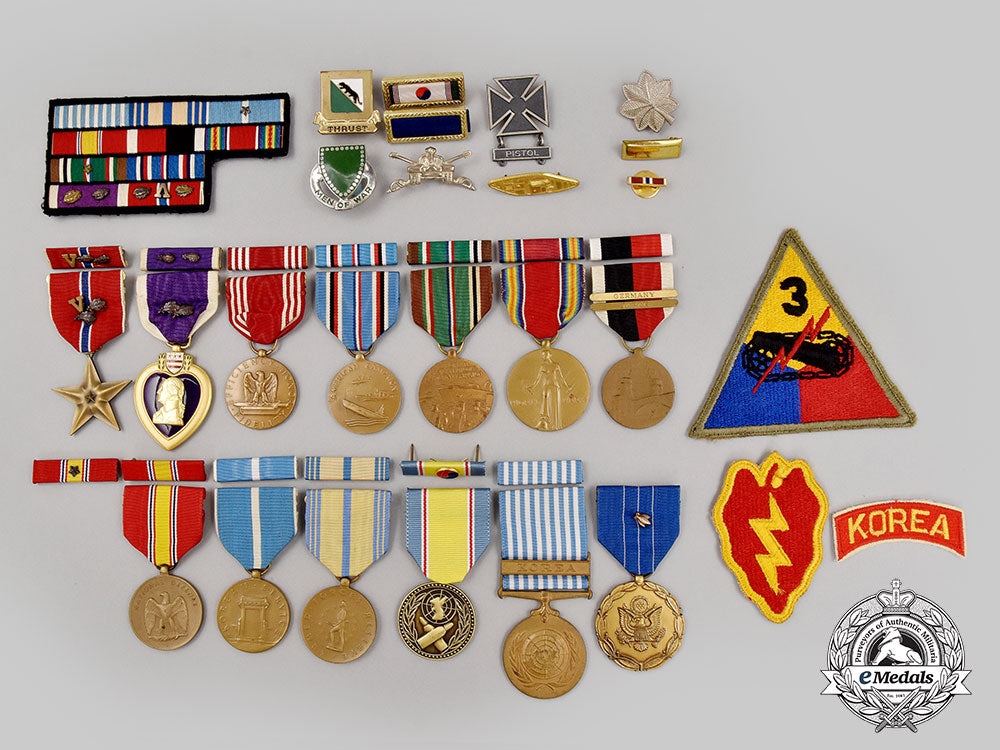
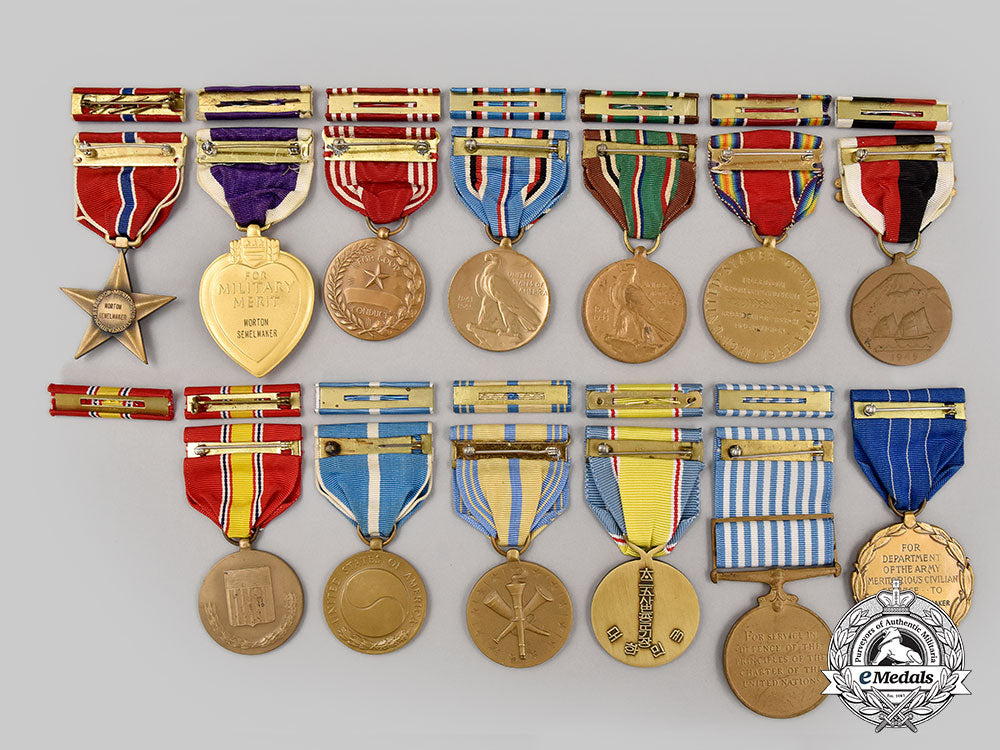
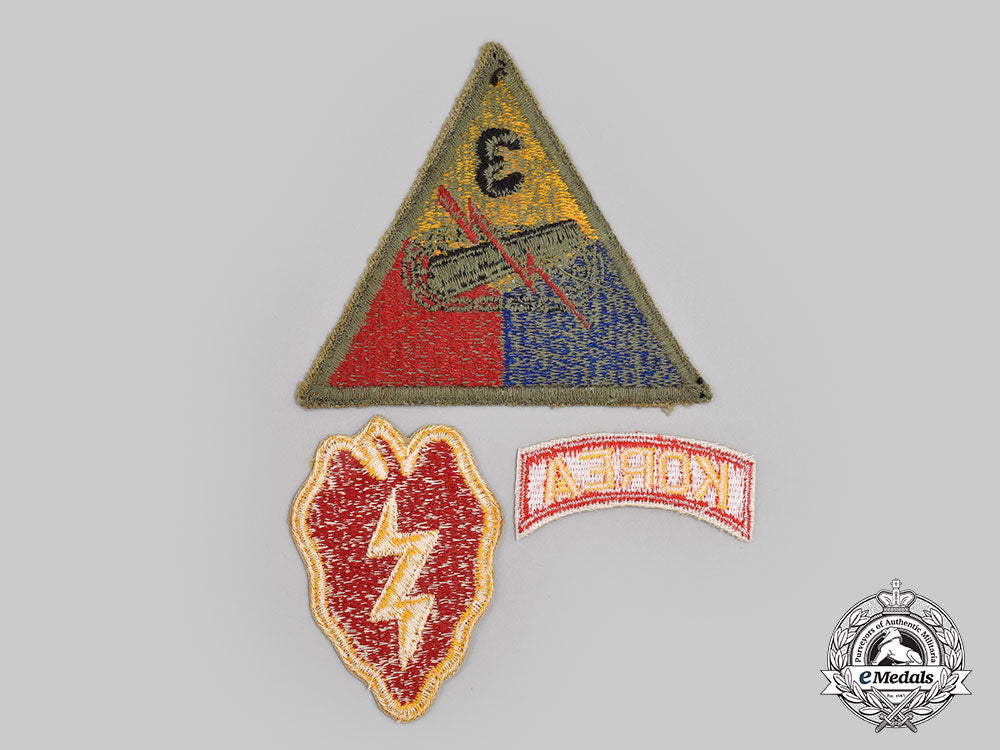
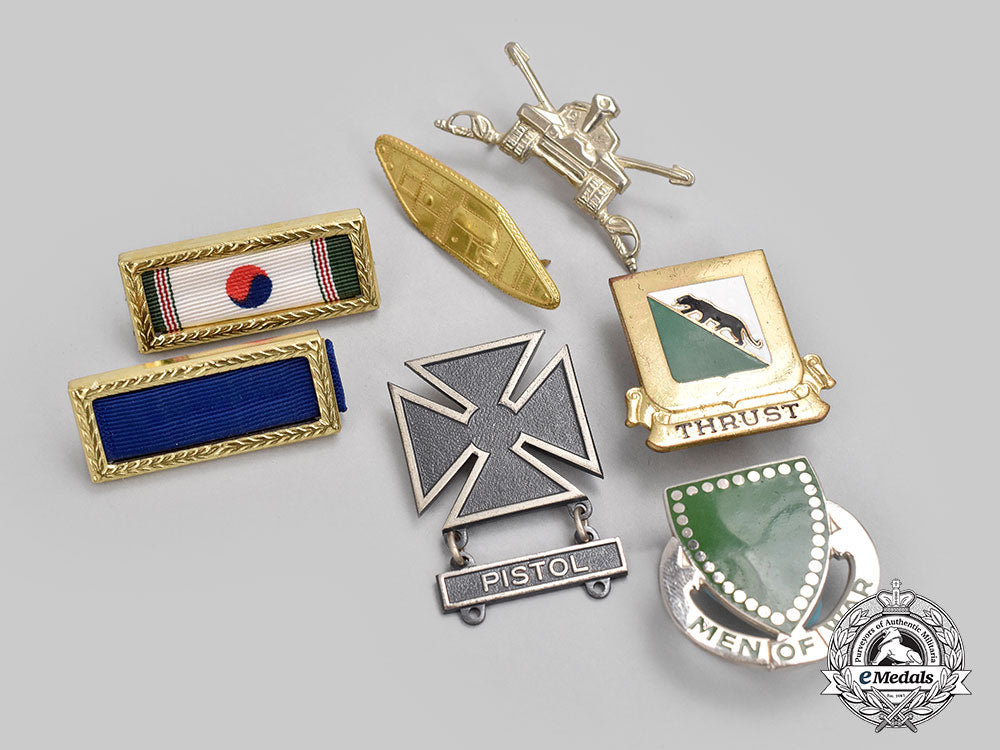
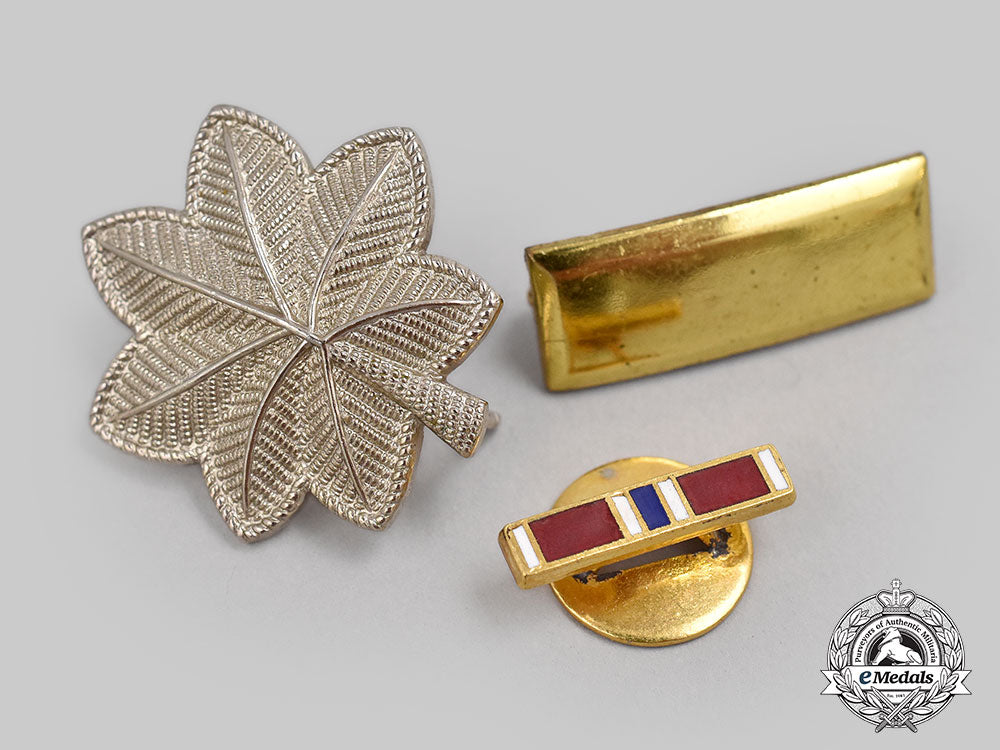
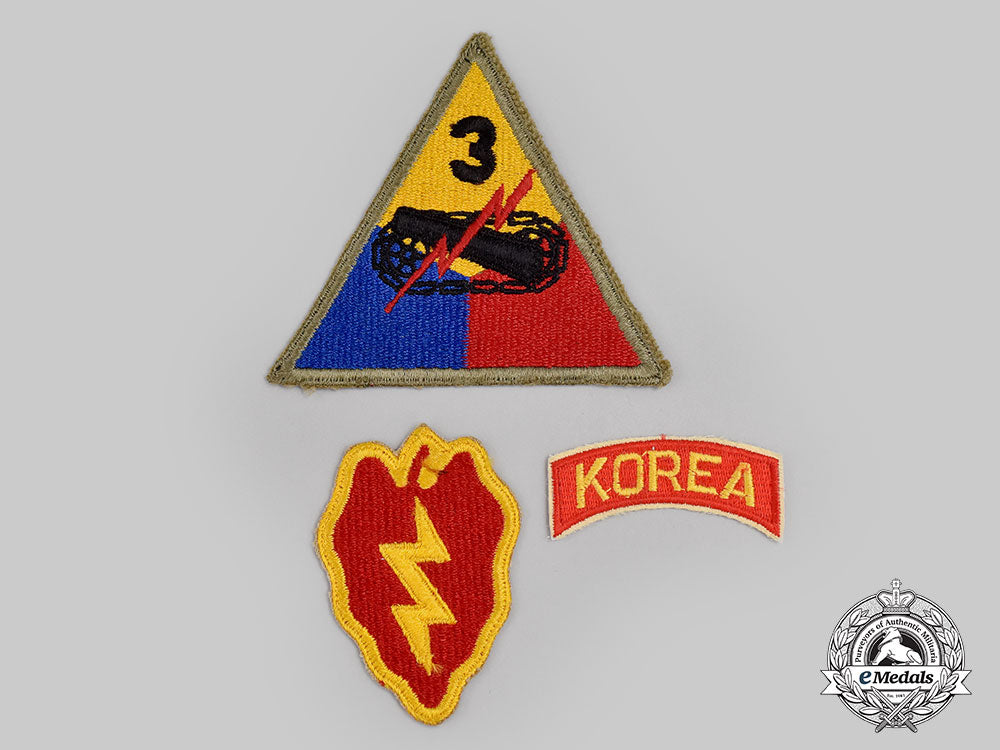
United States. A Bronze Star Second War & Korean War Group To First Lieutenan Semelmaker, 25Th Infantry Division
United States. A Bronze Star Second War & Korean War Group To First Lieutenan Semelmaker, 25Th Infantry Division
SKU: ITEM: W7411
Current Bid:
Your Max Bid:
Bid History:
Time Remaining:
Couldn't load pickup availability
Shipping Details
Shipping Details
eMedals offers rapid domestic and international shipping. Orders received prior to 12:00pm (EST) will be shipped on the same business day.* Orders placed on Canadian Federal holidays will be dispatched the subsequent business day. Courier tracking numbers are provided for all shipments. All items purchased from eMedals can be returned for a full monetary refund or merchandise credit, providing the criteria presented in our Terms & Conditions are met. *Please note that the addition of a COA may impact dispatch time.
Shipping Details
eMedals offers rapid domestic and international shipping. Orders received prior to 12:00pm (EST) will be shipped on the same business day.* Orders placed on Canadian Federal holidays will be dispatched the subsequent business day. Courier tracking numbers are provided for all shipments. All items purchased from eMedals can be returned for a full monetary refund or merchandise credit, providing the criteria presented in our Terms & Conditions are met. *Please note that the addition of a COA may impact dispatch time.
Description
Description
Includes:
1. Bronze Star Medal with two Oak Leaf Clusters and "V" Device, plus Ribbon Bar: engraved "MORTON SEMELMAKER" on the reverse.
2. Purple Heart with two Oak Leaf Clusters, plus Ribbon Bar: engraved "MORTON SEMELMAKER" on the reverse.
3. Army Good Conduct Medal with Ribbon Bar.
4. American Campaign Medal with Ribbon Bar.
5. European-African-Middle Eastern Campaign Medal with Ribbon Bar.
6. World War II Victory Medal with Ribbon Bar.
7. Army of Occupation Medal, 2 Clasps - JAPAN, GERMANY with Ribbon Bar.
8. National Defense Service Medal with two Ribbon Bars, one of which incorporates a Bronze Star.
9. Korean Service Medal with Ribbon Bar.
10. Armed Forces Reserve Medal for the Army with Ribbon Bar.
11. Republic of Korea War Service Medal with Ribbon Bar bearing an enameled Taegeuk.
12. United Nations Service Medal for Korea with Ribbon Bar.
13. Department of the Army Meritorious Civilian Service Award with Second Award Laurel Device. All thirteen medals with an original ribbon and brooch pinback. Also included are:
14. Army Presidential Unit Citation.
15. Republic of Korea Presidential Unit Citation.
16. Four-Level Ribbon Bar:
(i) Bronze Star Medal with two Oak Leaf Clusters and "V" Device / Purple Heart with two Oak Leaf Clusters.
(ii) American Campaign Medal / European-African-Middle Eastern Campaign Medal with Bronze Campaign Star.
(iii) World War II Victory Medal / Army of Occupation Medal / National Defense Service Medal.
(iv) Korean Service Medal with Silver Star / Armed Forces Reserve Medal for the Army / United Nations Service Medal for Korea. Ribbons on black wool with a black paper backer.
17. Bronze Star Medal Lapel Badge.
18. Second Lieutenant Rank Badge.
19. Lieutenant Colonel Rank Badge.
20. Army Marksman Marksmanship Qualification Badge with PISTOL clasp: badge in sterling silver, marked "KREW" and "STERLING" on the reverse, clasp marked "1/20 SF" (silver filled), hallmarked and marked "G1" on the reverse.
21. Armored Forces Branch Insignia: maker marked "A.E. CO. UTICA. N.Y." on the reverse.
22. Army Armor Officer Branch Insignia.
23. 33rd Armor Regiment "Men of War" Insignia Lapel Badge: in silvered metal with green enamels, marked "MADE IN U.S.A." and "E25" on the reverse, measuring 29 mm (w) x 29.3 mm (h).
24. 89th Tank Battalion "Thrust" Insignia Lapel Badge: in bronze gilt with green, white and black enamels, maker marked "N.S. MEYER, INC. NEW YORK" with the company's insignia on the reverse, measuring 30.3 mm (w) x 29.5 mm (h).
25. 25th Infantry Division Patch: in red and yellow embroidery, measuring 50 mm (w) x 73 mm (h).
26. Korea Shoulder Flash: in red, yellow and white embroidery, measuring 57 mm (w) x 20 mm (h).
27. 3rd Armored Division Patch: in red, blue, yellow, black and olive green embroidery, measuring 100 mm (w) x 90 mm (h). Accompanied by assorted research papers. Extremely fine.
Footnote: Morton Semelmaker was born on July 26, 1922 in New York City, his parents having been born in Poland and immigrated to the United States. His religion is stated as "Hebrew" (Jewish) in his records, his interests listed as baseball, basketball and football. He attended high school in New York City, after which he was employed as a Receiving Clerk with Henry Pollak Inc. of New York City for twelve months. He graded a "College Level A" on the General Education Development (GED) Test and would later attend the University of Maryland, where he would take a course in Military Science, complementing the numerous courses he would soon take at the Army's Armored School.
Semelmaker enlisted with the United States Army as a Corporal (01 019 109) and was posted to Company A, 41st Armored Regiment Group, 11th Armored Division at Polk, Louisiana from November 18, 1942 to November 5, 1943. He was commissioned as a Second Lieutenant on November 6, 1943, assuming the positions and duties of Platoon Leader, Tank Unit Commander and Track Vehicle Maintenance Officer with the 20th Armored Division, at the Armored School at Fort Knox, Kentucky.
Second Lieutenant Semelmaker was now prepared for service overseas with the United States Army, arriving in the European Theater of Operations, joining Company B, 33rd Armored Regiment, 3rd Armored Division in the closing days of the Second World War in February 1945. This was in conjunction with General George S. Patton's Third Army. By February 1945, the Germans were in full retreat and after a month of rest, the 3rd Armored Division resumed its offensive to the east. On February 26th, they rolled back inside Germany. In the following weeks, the 3rd bolted across the Roer River and seized several towns, crossed the Erft, and at last broke through to the Rhine River to capture Cologne by March 7th.
On March 31st, the commander of the division, Major General Maurice Rose, rounded a corner in his jeep and found himself face to face with a German tank. As he withdrew his pistol either to throw it to the ground or in an attempt to fight back, the young German tank commander, apparently misunderstanding Rose's intentions, shot and killed the general. After Cologne, the division swept up Paderborn in its advance to shut the back door to the Ruhr Pocket. In April, the division crossed the Saale River north of Halle and sped on toward the Elbe River.
On April 11, 1945, the 3rd Armored Division discovered the Dora-Mittelbau concentration camp. The division was the first to arrive on the scene, reporting back to headquarters that it had uncovered a large concentration camp near the town of Nordhausen. With help from the 104th Infantry Division, the 3rd immediately began transporting some 250 prisoners to nearby hospitals.
The division's last major fighting in the war was the Battle of Dessau, which the division captured on April 23, 1945 after three days of combat. Following the action at Dessau, the division moved into the corps reserve at Sangerhausen. Occupational duty near Langen was given to the division following V-E Day, a role it filled until inactivation on November 10, 1945. Post-war, Semelmaker was promoted to First Lieutenant on December 8, 1945.
By May 28, 1946, he assumed the roles of Criminals Investigation Officer and Platoon Commander with Companies C, D and A, 381st Military Police Service Battalion. On June 24, 1947, he was placed in the United States Army Reserve in the rank of Captain. He is acknowledged as having been a patient at the 97th General Hospital in Frankfurt for a week, before being evacuated to the United States, where he was admitted to Percy Jones General Hospital in Battle Creek, Michigan and hospitalized for the next for 157 days, the illness not stated in his records.
Semelmaker was in the rank of First Lieutenant in the United States Army as of July 1, 1948 and was a Training Officer, Assistant Training Officer and Fiscal Officer at Detroit, Michigan from 1948 to 1950. Upon the outbreak of the Korean War in 1950, First Lieutenant Semelmaker would soon see overseas service, as part of the American forces dedicated to rid communism from the Korean peninsula. He was posted to the Far East Command (FECOM) Japan from July 29, 1950 to July 10, 1951, where he took on the role of Platoon Leader with Company A, 89th Medium Tank Battalion and was Executive Officer with the 25th Reconnaissance Company, both part of the 25th Infantry Division. First Lieutenant Semelmaker was transferred to the Armored Division on October 16, 1950.
He is credited with being part of the United States Offensive and Defensive strategies against the Chinese Communist Forces (CCF) intervention as of April 1951, in the role of Armored Reconnaissance Unit Commander at Headquarters, 25th Infantry Division as of April 13, 1951. During the Korean War, Semelmaker would be recognized for his meritorious service and outstanding efforts, as he was named the recipient of the Bronze Star Medal on three occasions. Also, while in the Korean theater, he was awarded three Purple Hearts, the announcements of which appeared in the 25th Infantry Division GOs on September 8, 1950, on November 11, 1950 and in May 1951. The initial Purple Heart was followed by two Oak Leaf Clusters, recognizing the second and third issues of the award.
First Lieutenant Semelmaker would receive his first Bronze Star Medal, which was issued when he was a Tank Platoon Commander with Company A, 89th Medium Tank Battalion, "For meritorious service in connection with military operations against an enemy of the United States during the period 1 September to 5 September 1950.", his citation for the award stating: "First Lieutenant Morton Semelmaker, 01019109, Infantry, Company A, 89th Medium Tank Battalion, United States Army. During the period 1 September to 5 September 1950 Lieutenant Semelmaker served as leader of a tank platoon attached to an infantry battalion which was in defensive positions on the southern flank of the United Nations line in Korea.
Throughout this period Lieutenant Semelmaker led his platoon in a most commendable manner, neutralizing two road blocks and clearing the main supply route for the flow of vital materiel. On 3 September 1950 the tank platoon, under Lieutenant Semelmaker's leadership, covered the withdrawal of two rifle companies so skillfully that the companies were able to effect the displacement in an orderly manner with a minimum of casualties. Lieutenant Semelmaker's aggressive leadership, tactical skill and devotion to duty reflect the highest credit in himself and the United States Army."
First Lieutenant Semelmaker was with Armor, 25th Reconnaissance Company, when he was awarded the first Oak Leaf Cluster to the Bronze Star Medal with "V" Device, the latter denoting participation in acts of heroism involving conflict with an armed enemy, awarded for action near Munam-ni, Korea on April 11, 1951, his citation stating: "In the vicinity of Munam-ni, Korea on the morning of 11 April 1951, Lieutenant Semelmaker's unit was engaged in a sharp fire fight with an attacking hostile force. Repeatedly exposing himself to heavy small arms and automatic weapons fire, he moved throughout the position to administer to the needs of the wounded. Inspiring his men to maximum effort, he conducted a spirited defense that caused the foe to withdraw."
Lieutenant Semelmaker's courage, leadership and selfless devotion to duty reflect great credit on himself and the Armed Forces." First Lieutenant Semelmaker was a Motor Officer with Armor, 25th Reconnaissance Company, when he was awarded the second Oak Leaf Cluster to the Bronze Star Medal, "For meritorious service in connection with military operations against an enemy of the United States during the period 13 December 1950 to 19 May 1951.", his citation for the award stating: "First Lieutenant Morton Semelmaker, 01019109, Armor, 25th Reconnaissance Company, United States Army.
From 10 December 1950 to 19 March 1951, Lieutenant Semelmaker served with distinction as a motor officer in Korea. Despite limited facilities, adverse weather and the necessity for continuous operation over rugged terrain, he exhibited notable initiative, great ingenuity and outstanding leadership in developing a highly skilled motor section that maintained the mobility of the Company throughout the campaign. By organizing a motorized crew for on-the-spot maintenance and recovery service, he was instrumental in preventing several vehicles from falling into enemy hands.
On one occasion, he led his men on foot to within a few hundred yards of hostile lines to recover two disabled tanks. Lieutenant Semelmaker's courage, determination and exemplary devotion to duty are in keeping with the high traditions of the United States Army." In June 1951, he returned to the Continental United States (CONUS), taking the rank of Captain on July 18, 1951. From August 1951 to May 1952, he was posted to the 3rd Armored Cavalry Regiment at Fort Meade, Maryland, performing the duties of an Operations and Training Officer.
This was followed by a posting in May 1952 to the Armored School at Fort Knox, Kentucky. He is listed as a Captain in the United States Army Reserve as of October 3, 1952. Semelmaker returned to the 3rd Armored Cavalry Regiment Group, this time at Pickett, Virginia, where he performed the duties of a Liaison Officer and Comb. Intelligence Staff Officer from August 1952 to May 1953, at which point he soon found himself enroute to the United States Army Reserve in Europe (USAREUR). While in Europe, as of August 1953, he assumed the role of Tank Commander with the 169th Infantry Regiment, which was re-designated the 39th Infantry Regiment, achieving the Army Marksman Marksmanship Qualification Badge with Pistol clasp on February 11, 1955, and would remain with the 39th Infantry Regiment as a Tank Commander until March 1, 1955, when he was transferred to Headquarters of the 39th Infantry Regiment.
Semelmaker was promoted to the rank of Major with the United States Army Reserve on November 5, 1955. He returned to the United States, posted to the Headquarters Company, 39th Infantry Regiment at Fort Carson, Colorado in July 1956. As of January 1957, he was with Headquarters, 9th Infantry Division at Fort Carson. Semelmaker is documented as having been a Battalion Advisor with the Pennsylvania Army National Guard at Lewistown, Pennsylvania as of September 1957. Again with the United States Army Reserve in Europe, he was posted to the Headquarters Company, 2nd Battalion, 11th Armored Cavalry, later re-designed as 2nd Reconnaissance Squadron, from October 19, 1959, seeing a promotion to Major in the United States Army as of December 9, 1959.
As of July 17, 1961, he was transferred to 7th Army Headquarters USAREUR until July 1962. He was promoted to Lieutenant Colonel with the United States Army Reserve on November 4, 1962. During his career, in addition to the aforementioned three Bronze Star Medals and the three Purple Hearts awarded, Semelmaker was awarded the Army Good Conduct Medal. For his Second World War service, he was awarded the American Campaign Medal, the European-African-Middle Eastern Campaign Medal with Bronze Campaign Star, the World War II Victory Medal and the Army Presidential Unit Citation.
Postwar, he was awarded the Army of Occupation Medal with Japan and Germany clasps, along with the National Defense Service Medal. For his Korean War service, he was awarded the Korean Service Medal with Silver Star, the Republic of Korea War Service Medal, the Republic of Korea Presidential Unit Citation and the United Nations Service Medal for Korea. Major Semelmaker retired after more than twenty years' service on December 31, 1962, achieving the rank of Lieutenant Colonel effective January 1, 1963.
He was later employed by the Department of the Army Civilian, where he would achieve the Department of the Army Meritorious Civilian Service Award with a Second Award Laurel Device. Morton Semelmaker died on February 23,1997, at the age of 74 and is buried in El Camino Memorial Park in San Diego, San Diego County, California, Arlington Point Plot 347. He was married to Florence Semelmaker (born: November 6, 1926 in Detroit), who died on October 28, 2015, at the age of 88 and is buried beside her husband. They couple had two children.
Description
Includes:
1. Bronze Star Medal with two Oak Leaf Clusters and "V" Device, plus Ribbon Bar: engraved "MORTON SEMELMAKER" on the reverse.
2. Purple Heart with two Oak Leaf Clusters, plus Ribbon Bar: engraved "MORTON SEMELMAKER" on the reverse.
3. Army Good Conduct Medal with Ribbon Bar.
4. American Campaign Medal with Ribbon Bar.
5. European-African-Middle Eastern Campaign Medal with Ribbon Bar.
6. World War II Victory Medal with Ribbon Bar.
7. Army of Occupation Medal, 2 Clasps - JAPAN, GERMANY with Ribbon Bar.
8. National Defense Service Medal with two Ribbon Bars, one of which incorporates a Bronze Star.
9. Korean Service Medal with Ribbon Bar.
10. Armed Forces Reserve Medal for the Army with Ribbon Bar.
11. Republic of Korea War Service Medal with Ribbon Bar bearing an enameled Taegeuk.
12. United Nations Service Medal for Korea with Ribbon Bar.
13. Department of the Army Meritorious Civilian Service Award with Second Award Laurel Device. All thirteen medals with an original ribbon and brooch pinback. Also included are:
14. Army Presidential Unit Citation.
15. Republic of Korea Presidential Unit Citation.
16. Four-Level Ribbon Bar:
(i) Bronze Star Medal with two Oak Leaf Clusters and "V" Device / Purple Heart with two Oak Leaf Clusters.
(ii) American Campaign Medal / European-African-Middle Eastern Campaign Medal with Bronze Campaign Star.
(iii) World War II Victory Medal / Army of Occupation Medal / National Defense Service Medal.
(iv) Korean Service Medal with Silver Star / Armed Forces Reserve Medal for the Army / United Nations Service Medal for Korea. Ribbons on black wool with a black paper backer.
17. Bronze Star Medal Lapel Badge.
18. Second Lieutenant Rank Badge.
19. Lieutenant Colonel Rank Badge.
20. Army Marksman Marksmanship Qualification Badge with PISTOL clasp: badge in sterling silver, marked "KREW" and "STERLING" on the reverse, clasp marked "1/20 SF" (silver filled), hallmarked and marked "G1" on the reverse.
21. Armored Forces Branch Insignia: maker marked "A.E. CO. UTICA. N.Y." on the reverse.
22. Army Armor Officer Branch Insignia.
23. 33rd Armor Regiment "Men of War" Insignia Lapel Badge: in silvered metal with green enamels, marked "MADE IN U.S.A." and "E25" on the reverse, measuring 29 mm (w) x 29.3 mm (h).
24. 89th Tank Battalion "Thrust" Insignia Lapel Badge: in bronze gilt with green, white and black enamels, maker marked "N.S. MEYER, INC. NEW YORK" with the company's insignia on the reverse, measuring 30.3 mm (w) x 29.5 mm (h).
25. 25th Infantry Division Patch: in red and yellow embroidery, measuring 50 mm (w) x 73 mm (h).
26. Korea Shoulder Flash: in red, yellow and white embroidery, measuring 57 mm (w) x 20 mm (h).
27. 3rd Armored Division Patch: in red, blue, yellow, black and olive green embroidery, measuring 100 mm (w) x 90 mm (h). Accompanied by assorted research papers. Extremely fine.
Footnote: Morton Semelmaker was born on July 26, 1922 in New York City, his parents having been born in Poland and immigrated to the United States. His religion is stated as "Hebrew" (Jewish) in his records, his interests listed as baseball, basketball and football. He attended high school in New York City, after which he was employed as a Receiving Clerk with Henry Pollak Inc. of New York City for twelve months. He graded a "College Level A" on the General Education Development (GED) Test and would later attend the University of Maryland, where he would take a course in Military Science, complementing the numerous courses he would soon take at the Army's Armored School.
Semelmaker enlisted with the United States Army as a Corporal (01 019 109) and was posted to Company A, 41st Armored Regiment Group, 11th Armored Division at Polk, Louisiana from November 18, 1942 to November 5, 1943. He was commissioned as a Second Lieutenant on November 6, 1943, assuming the positions and duties of Platoon Leader, Tank Unit Commander and Track Vehicle Maintenance Officer with the 20th Armored Division, at the Armored School at Fort Knox, Kentucky.
Second Lieutenant Semelmaker was now prepared for service overseas with the United States Army, arriving in the European Theater of Operations, joining Company B, 33rd Armored Regiment, 3rd Armored Division in the closing days of the Second World War in February 1945. This was in conjunction with General George S. Patton's Third Army. By February 1945, the Germans were in full retreat and after a month of rest, the 3rd Armored Division resumed its offensive to the east. On February 26th, they rolled back inside Germany. In the following weeks, the 3rd bolted across the Roer River and seized several towns, crossed the Erft, and at last broke through to the Rhine River to capture Cologne by March 7th.
On March 31st, the commander of the division, Major General Maurice Rose, rounded a corner in his jeep and found himself face to face with a German tank. As he withdrew his pistol either to throw it to the ground or in an attempt to fight back, the young German tank commander, apparently misunderstanding Rose's intentions, shot and killed the general. After Cologne, the division swept up Paderborn in its advance to shut the back door to the Ruhr Pocket. In April, the division crossed the Saale River north of Halle and sped on toward the Elbe River.
On April 11, 1945, the 3rd Armored Division discovered the Dora-Mittelbau concentration camp. The division was the first to arrive on the scene, reporting back to headquarters that it had uncovered a large concentration camp near the town of Nordhausen. With help from the 104th Infantry Division, the 3rd immediately began transporting some 250 prisoners to nearby hospitals.
The division's last major fighting in the war was the Battle of Dessau, which the division captured on April 23, 1945 after three days of combat. Following the action at Dessau, the division moved into the corps reserve at Sangerhausen. Occupational duty near Langen was given to the division following V-E Day, a role it filled until inactivation on November 10, 1945. Post-war, Semelmaker was promoted to First Lieutenant on December 8, 1945.
By May 28, 1946, he assumed the roles of Criminals Investigation Officer and Platoon Commander with Companies C, D and A, 381st Military Police Service Battalion. On June 24, 1947, he was placed in the United States Army Reserve in the rank of Captain. He is acknowledged as having been a patient at the 97th General Hospital in Frankfurt for a week, before being evacuated to the United States, where he was admitted to Percy Jones General Hospital in Battle Creek, Michigan and hospitalized for the next for 157 days, the illness not stated in his records.
Semelmaker was in the rank of First Lieutenant in the United States Army as of July 1, 1948 and was a Training Officer, Assistant Training Officer and Fiscal Officer at Detroit, Michigan from 1948 to 1950. Upon the outbreak of the Korean War in 1950, First Lieutenant Semelmaker would soon see overseas service, as part of the American forces dedicated to rid communism from the Korean peninsula. He was posted to the Far East Command (FECOM) Japan from July 29, 1950 to July 10, 1951, where he took on the role of Platoon Leader with Company A, 89th Medium Tank Battalion and was Executive Officer with the 25th Reconnaissance Company, both part of the 25th Infantry Division. First Lieutenant Semelmaker was transferred to the Armored Division on October 16, 1950.
He is credited with being part of the United States Offensive and Defensive strategies against the Chinese Communist Forces (CCF) intervention as of April 1951, in the role of Armored Reconnaissance Unit Commander at Headquarters, 25th Infantry Division as of April 13, 1951. During the Korean War, Semelmaker would be recognized for his meritorious service and outstanding efforts, as he was named the recipient of the Bronze Star Medal on three occasions. Also, while in the Korean theater, he was awarded three Purple Hearts, the announcements of which appeared in the 25th Infantry Division GOs on September 8, 1950, on November 11, 1950 and in May 1951. The initial Purple Heart was followed by two Oak Leaf Clusters, recognizing the second and third issues of the award.
First Lieutenant Semelmaker would receive his first Bronze Star Medal, which was issued when he was a Tank Platoon Commander with Company A, 89th Medium Tank Battalion, "For meritorious service in connection with military operations against an enemy of the United States during the period 1 September to 5 September 1950.", his citation for the award stating: "First Lieutenant Morton Semelmaker, 01019109, Infantry, Company A, 89th Medium Tank Battalion, United States Army. During the period 1 September to 5 September 1950 Lieutenant Semelmaker served as leader of a tank platoon attached to an infantry battalion which was in defensive positions on the southern flank of the United Nations line in Korea.
Throughout this period Lieutenant Semelmaker led his platoon in a most commendable manner, neutralizing two road blocks and clearing the main supply route for the flow of vital materiel. On 3 September 1950 the tank platoon, under Lieutenant Semelmaker's leadership, covered the withdrawal of two rifle companies so skillfully that the companies were able to effect the displacement in an orderly manner with a minimum of casualties. Lieutenant Semelmaker's aggressive leadership, tactical skill and devotion to duty reflect the highest credit in himself and the United States Army."
First Lieutenant Semelmaker was with Armor, 25th Reconnaissance Company, when he was awarded the first Oak Leaf Cluster to the Bronze Star Medal with "V" Device, the latter denoting participation in acts of heroism involving conflict with an armed enemy, awarded for action near Munam-ni, Korea on April 11, 1951, his citation stating: "In the vicinity of Munam-ni, Korea on the morning of 11 April 1951, Lieutenant Semelmaker's unit was engaged in a sharp fire fight with an attacking hostile force. Repeatedly exposing himself to heavy small arms and automatic weapons fire, he moved throughout the position to administer to the needs of the wounded. Inspiring his men to maximum effort, he conducted a spirited defense that caused the foe to withdraw."
Lieutenant Semelmaker's courage, leadership and selfless devotion to duty reflect great credit on himself and the Armed Forces." First Lieutenant Semelmaker was a Motor Officer with Armor, 25th Reconnaissance Company, when he was awarded the second Oak Leaf Cluster to the Bronze Star Medal, "For meritorious service in connection with military operations against an enemy of the United States during the period 13 December 1950 to 19 May 1951.", his citation for the award stating: "First Lieutenant Morton Semelmaker, 01019109, Armor, 25th Reconnaissance Company, United States Army.
From 10 December 1950 to 19 March 1951, Lieutenant Semelmaker served with distinction as a motor officer in Korea. Despite limited facilities, adverse weather and the necessity for continuous operation over rugged terrain, he exhibited notable initiative, great ingenuity and outstanding leadership in developing a highly skilled motor section that maintained the mobility of the Company throughout the campaign. By organizing a motorized crew for on-the-spot maintenance and recovery service, he was instrumental in preventing several vehicles from falling into enemy hands.
On one occasion, he led his men on foot to within a few hundred yards of hostile lines to recover two disabled tanks. Lieutenant Semelmaker's courage, determination and exemplary devotion to duty are in keeping with the high traditions of the United States Army." In June 1951, he returned to the Continental United States (CONUS), taking the rank of Captain on July 18, 1951. From August 1951 to May 1952, he was posted to the 3rd Armored Cavalry Regiment at Fort Meade, Maryland, performing the duties of an Operations and Training Officer.
This was followed by a posting in May 1952 to the Armored School at Fort Knox, Kentucky. He is listed as a Captain in the United States Army Reserve as of October 3, 1952. Semelmaker returned to the 3rd Armored Cavalry Regiment Group, this time at Pickett, Virginia, where he performed the duties of a Liaison Officer and Comb. Intelligence Staff Officer from August 1952 to May 1953, at which point he soon found himself enroute to the United States Army Reserve in Europe (USAREUR). While in Europe, as of August 1953, he assumed the role of Tank Commander with the 169th Infantry Regiment, which was re-designated the 39th Infantry Regiment, achieving the Army Marksman Marksmanship Qualification Badge with Pistol clasp on February 11, 1955, and would remain with the 39th Infantry Regiment as a Tank Commander until March 1, 1955, when he was transferred to Headquarters of the 39th Infantry Regiment.
Semelmaker was promoted to the rank of Major with the United States Army Reserve on November 5, 1955. He returned to the United States, posted to the Headquarters Company, 39th Infantry Regiment at Fort Carson, Colorado in July 1956. As of January 1957, he was with Headquarters, 9th Infantry Division at Fort Carson. Semelmaker is documented as having been a Battalion Advisor with the Pennsylvania Army National Guard at Lewistown, Pennsylvania as of September 1957. Again with the United States Army Reserve in Europe, he was posted to the Headquarters Company, 2nd Battalion, 11th Armored Cavalry, later re-designed as 2nd Reconnaissance Squadron, from October 19, 1959, seeing a promotion to Major in the United States Army as of December 9, 1959.
As of July 17, 1961, he was transferred to 7th Army Headquarters USAREUR until July 1962. He was promoted to Lieutenant Colonel with the United States Army Reserve on November 4, 1962. During his career, in addition to the aforementioned three Bronze Star Medals and the three Purple Hearts awarded, Semelmaker was awarded the Army Good Conduct Medal. For his Second World War service, he was awarded the American Campaign Medal, the European-African-Middle Eastern Campaign Medal with Bronze Campaign Star, the World War II Victory Medal and the Army Presidential Unit Citation.
Postwar, he was awarded the Army of Occupation Medal with Japan and Germany clasps, along with the National Defense Service Medal. For his Korean War service, he was awarded the Korean Service Medal with Silver Star, the Republic of Korea War Service Medal, the Republic of Korea Presidential Unit Citation and the United Nations Service Medal for Korea. Major Semelmaker retired after more than twenty years' service on December 31, 1962, achieving the rank of Lieutenant Colonel effective January 1, 1963.
He was later employed by the Department of the Army Civilian, where he would achieve the Department of the Army Meritorious Civilian Service Award with a Second Award Laurel Device. Morton Semelmaker died on February 23,1997, at the age of 74 and is buried in El Camino Memorial Park in San Diego, San Diego County, California, Arlington Point Plot 347. He was married to Florence Semelmaker (born: November 6, 1926 in Detroit), who died on October 28, 2015, at the age of 88 and is buried beside her husband. They couple had two children.
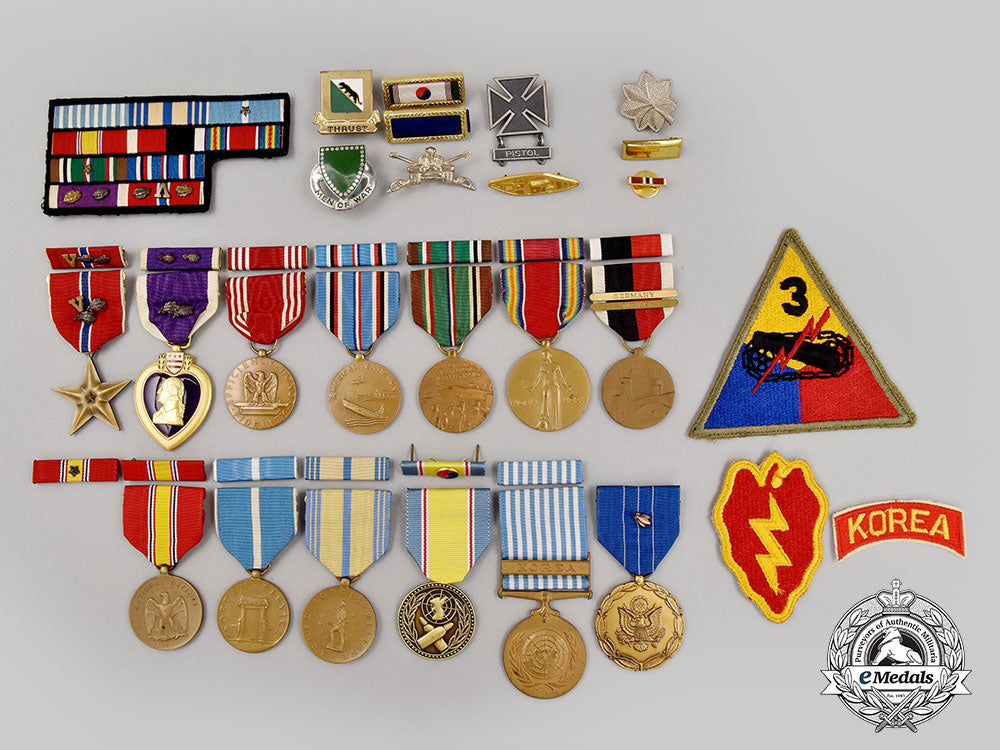
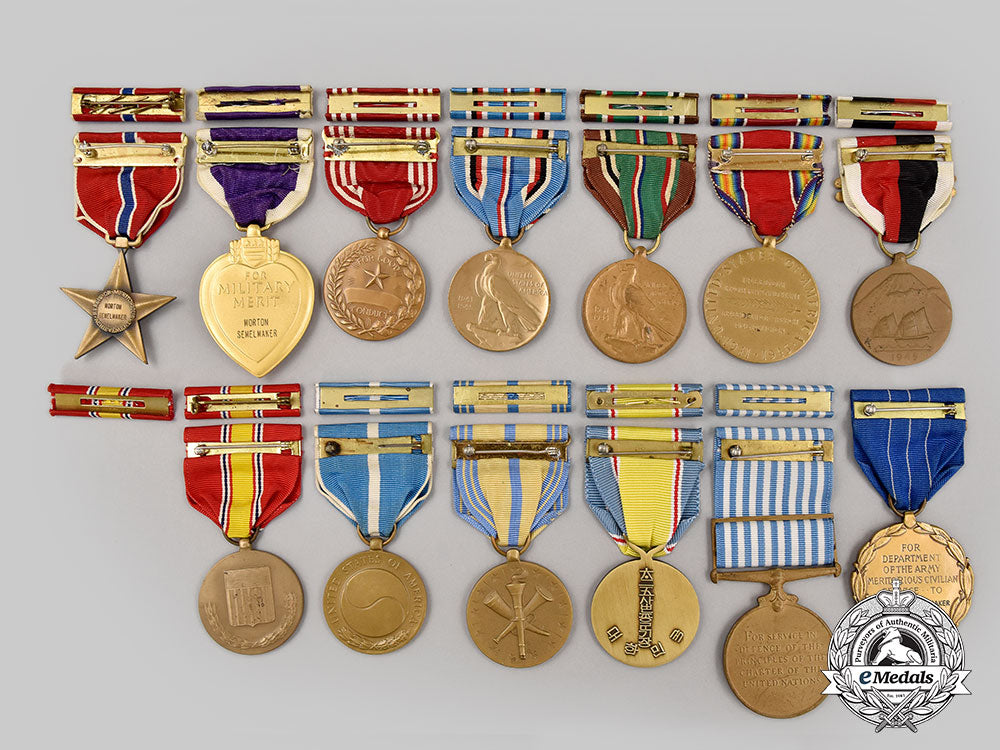
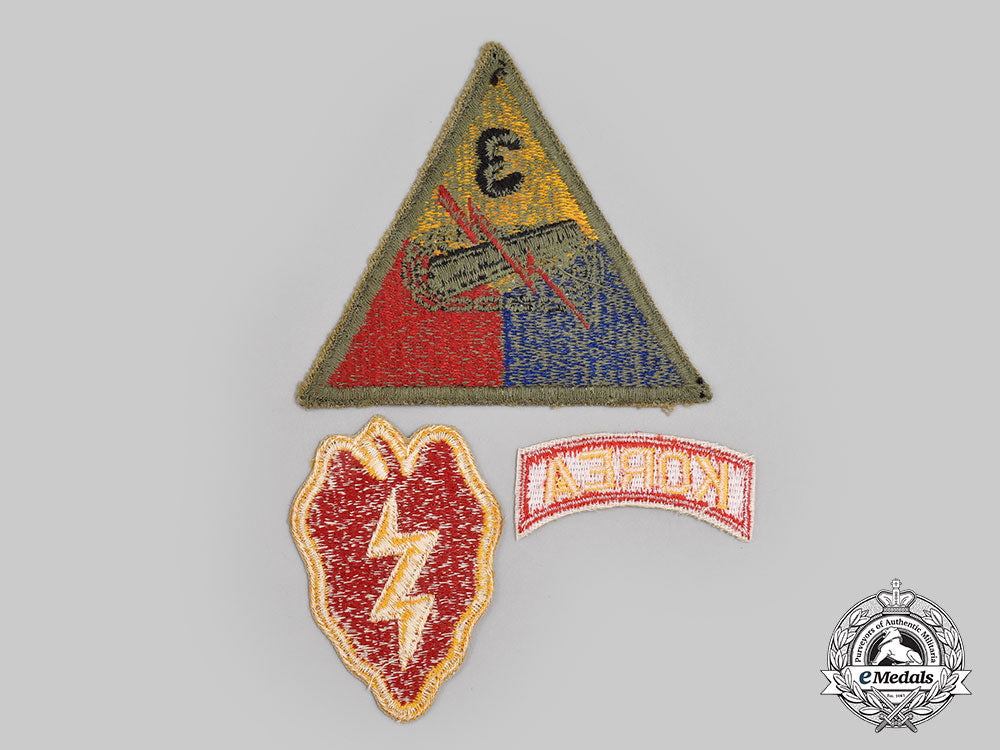
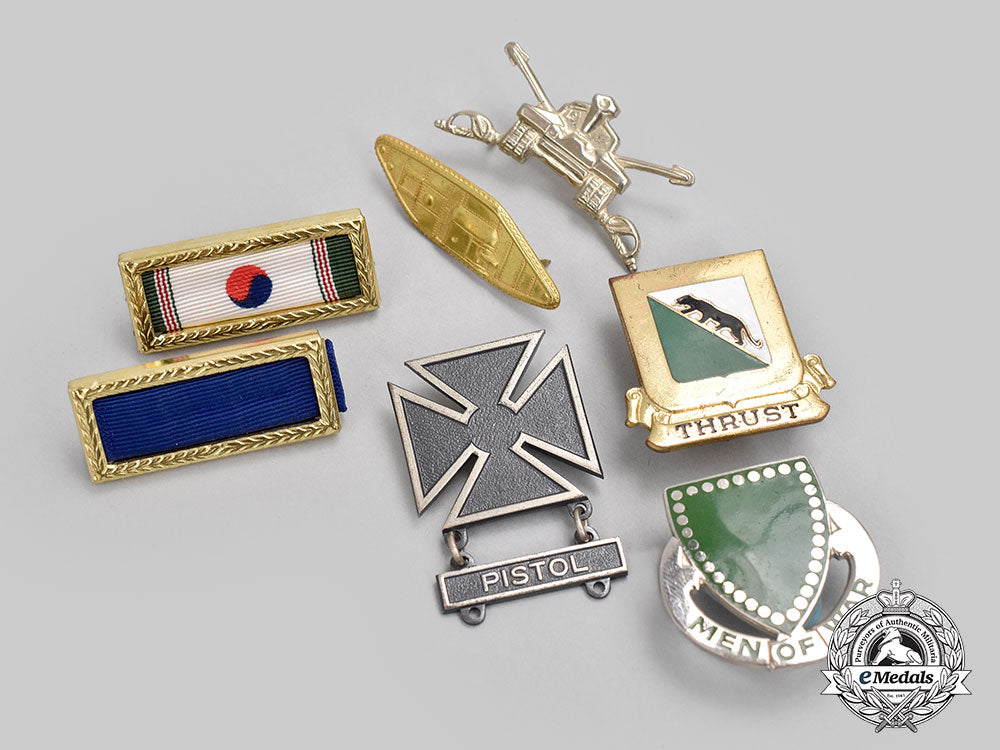
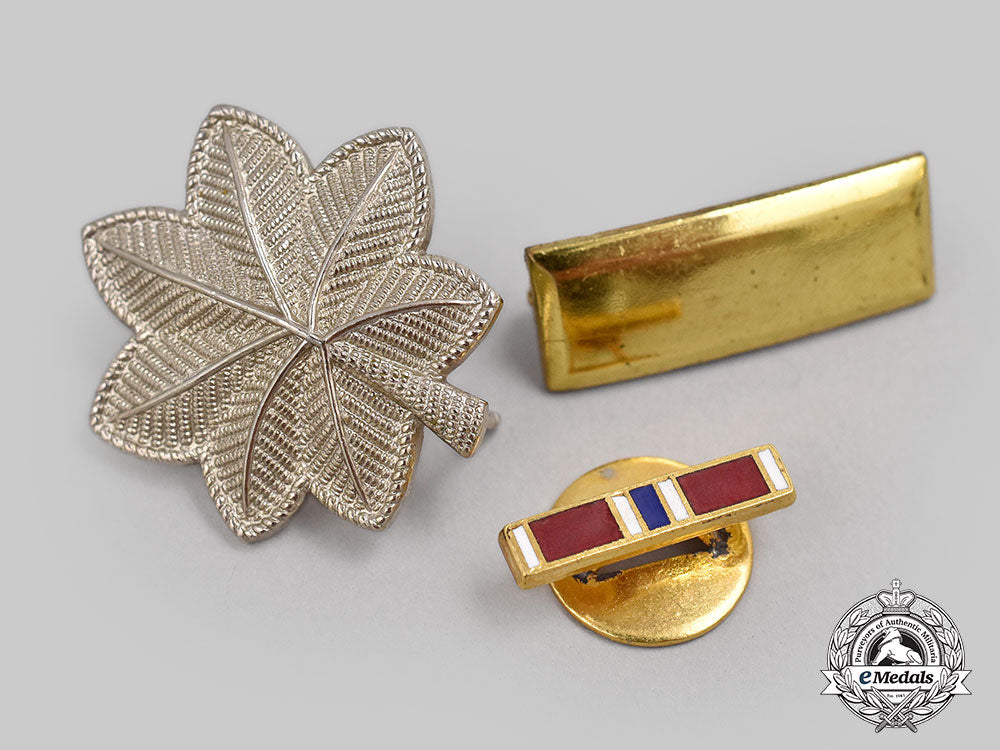
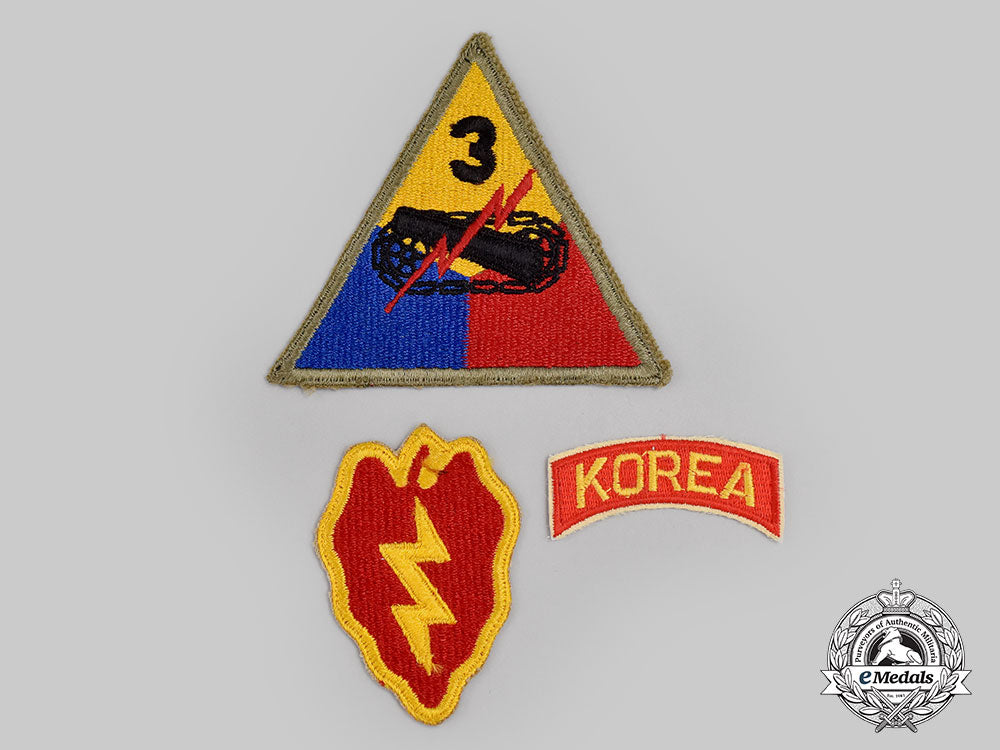
You May Also Like
Germany, SA. A Model 1933 Service Dagger, SA-Gruppe Nordsee, by Friedrich von der Kohlen
G59818
Germany, SA. A Model 1933 Service Dagger, SA-Gruppe Pommern, by Gustav Wirth
G59816
Germany, Third Reich. A Mixed Lot of Tyrolean Marksmanship Badges
G52930
Germany, SS. An Estonian Waffen-SS Volunteer’s Sleeve Shield
G50381
Germany, SS. A Waffen-SS Sturmmann Sleeve Insignia
G52846
-
Germany, SA. A Model 1933 Service Dagger, SA-Gruppe Nordsee, by Friedrich von der Kohlen
G59818
Add to CartRegular price $980 USDRegular price $0 USD Sale price $980 USDUnit price / per -
Germany, SA. A Model 1933 Service Dagger, SA-Gruppe Pommern, by Gustav Wirth
G59816
Add to CartRegular price $980 USDRegular price $0 USD Sale price $980 USDUnit price / per -
Germany, Third Reich. A Mixed Lot of Tyrolean Marksmanship Badges
G52930
Add to CartRegular price $135 USDRegular price $0 USD Sale price $135 USDUnit price / per -
Germany, SS. An Estonian Waffen-SS Volunteer’s Sleeve Shield
G50381
Add to CartRegular price $150 USDRegular price $0 USD Sale price $150 USDUnit price / per -
Germany, SS. A Waffen-SS Sturmmann Sleeve Insignia
G52846
Add to CartRegular price $135 USDRegular price $0 USD Sale price $135 USDUnit price / per
Do you have a similar item you are interested in selling?
Please complete the form and our client care representatives will contact you.
Sell Item
















